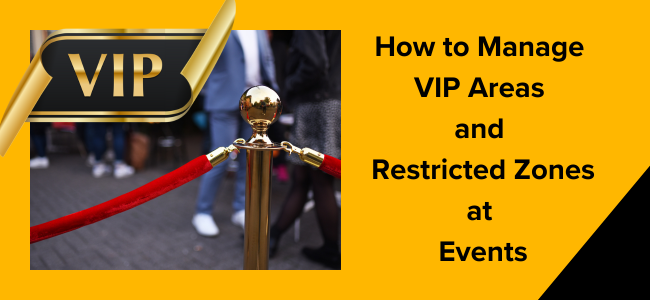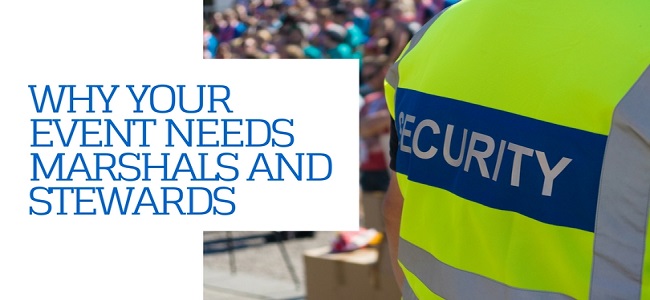
How to Manage VIP Areas and Restricted Zones at Events
How to Manage VIP Areas and Restricted Zones at Events
Managing VIP areas and restricted zones at events is crucial for ensuring security, exclusivity, and a smooth experience for guests. Whether it’s a music festival, sports event, corporate gathering, or political summit, well-managed restricted zones protect high-profile guests, prevent crowding, and maintain order. This is where event marshals and stewards play a critical role.
Why Have VIP Areas and Restricted Zones?
VIP areas and restricted zones exist to:
Ensure security – Protecting high-profile guests from unwanted interactions or potential threats.
Enhance guest experience – Providing an exclusive and comfortable environment for VIP attendees.
Control crowd flow – Preventing unauthorised access to sensitive areas like backstage, press zones, or technical control rooms.
Maintain order – Ensuring only those with the correct credentials can access designated areas.
The Role of Marshals and Stewards in Managing VIP and Restricted Areas
Event marshals and stewards are essential in maintaining the integrity of restricted areas. Their responsibilities include:
Access control – Checking credentials, scanning tickets, and verifying guest lists.
Security enforcement – Preventing unauthorised entry and handling disturbances.
Guest assistance – Directing VIPs to their designated areas and ensuring their needs are met.
Emergency response – Assisting in evacuation or responding to medical emergencies.
Monitoring and reporting – Observing any suspicious activity and reporting it to security teams.
Key Strategies for Managing VIP Areas and Restricted Zones
1. Strategic Planning and Layout Design
A well-thought-out layout is essential for effective VIP area management. Consider:
Location – Ensure the area is accessible yet secluded from general attendees.
Entrances and exits – Designate specific entry and exit points with security checks.
Barriers and signage – Use fencing, retractable barriers, and clear signage to prevent confusion.
Escape routes – Ensure emergency exits are visible and easily accessible.
2. Implementing Strict Access Control
One of the biggest challenges in managing VIP zones is preventing unauthorised access. Solutions include:
Credentialing systems – Use wristbands, lanyards, RFID passes, or biometric access for authentication.
Multiple security layers – Place stewards at initial checkpoints and marshals at high-security areas.
Guest lists and pre-approval – Verify identities before the event and maintain a real-time list of authorised personnel.
3. Deploying Trained Marshals and Stewards Effectively
The effectiveness of your VIP area depends on how well your team is positioned and trained.
Positioning – Place stewards at entrances, exits, and within VIP lounges, while marshals oversee and coordinate operations.
Training – Ensure staff is trained in conflict resolution, emergency response, and professional conduct.
Communication – Use radios or earpieces for real-time coordination among security teams.
4. Monitoring and Surveillance
A combination of human oversight and technology enhances security in restricted areas.
CCTV monitoring – Install surveillance cameras to keep an eye on entry points and guest interactions.
Mobile security teams – Assign marshals to patrol the area and respond to incidents swiftly.
Incident reporting – Train staff to document and report any breaches or suspicious activities.
5. Handling Unauthorised Access and Security Breaches
Despite best efforts, unauthorised access attempts can occur. Steps to manage breaches include:
Immediate intervention – Stewards should approach unauthorised individuals calmly and request them to leave.
Escalation protocols – If a person refuses to comply, involve a senior marshal or on-site security personnel.
Legal compliance – Ensure that all actions taken comply with event security regulations and laws.
6. Providing Excellent VIP Guest Experience
Managing a VIP area isn’t just about security—it’s also about service.
Concierge-style assistance – Assign stewards to guide VIPs to their seats, assist with amenities, and answer queries.
Comfort and hospitality – Ensure VIP areas have adequate seating, refreshments, and restroom access.
Privacy management – Use draped-off areas or tinted glass to provide discretion where needed.
7. Emergency Preparedness
VIP areas must have emergency response plans in place.
Medical teams on standby – Ensure first-aid personnel are present near VIP zones.
Evacuation protocols – Train staff on swift and discreet evacuation methods for high-profile guests.
Crisis communication – Develop a system for informing VIPs about potential threats without causing panic.
Managing VIP areas and restricted zones at events requires a balance between security, crowd control, and hospitality. By strategically using marshals and stewards, implementing strict access control, leveraging technology, and prioritising guest experience, event organisers can ensure a smooth and secure environment for VIP attendees. Investing in trained personnel and robust management strategies will elevate the success and reputation of any event.
By following these best practices, you can ensure that your event’s VIP areas remain exclusive, secure, and well-managed—allowing both guests and organisers to enjoy a stress-free experience.



